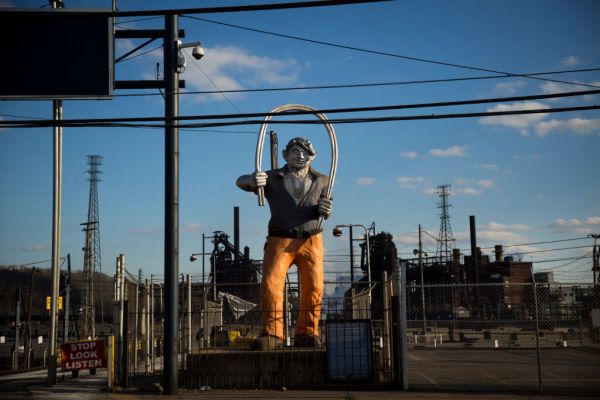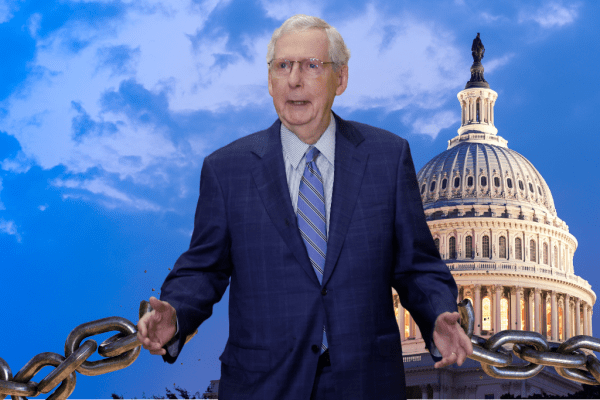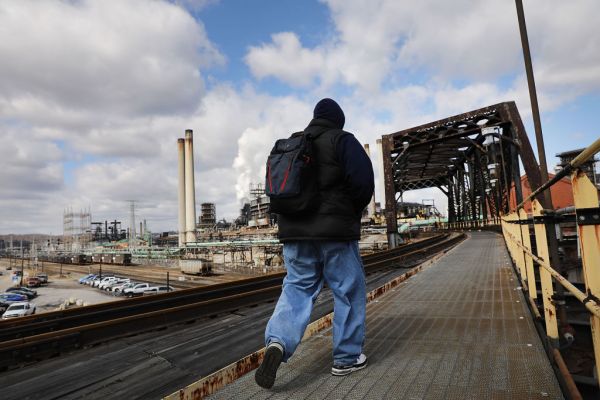At a campaign rally in Michigan a few weeks before she dropped out of the presidential race, Nikki Haley warned the frontrunner in the Republican primary.
“He’s not going to get the 40 percent if he’s going and calling out my supporters and saying they’re barred permanently from MAGA,” she vowed. “He’s not going to get the 40 percent by calling them names. He’s not going to get the 40 percent by trying to take over the RNC.”
Haley had plucked the “40 percent” figure from the results of South Carolina’s primary, where she received almost precisely that share of the vote. To hear her tell it, you would think that number represented the percentage of Republican voters who are reluctant to vote for Donald Trump again but might be persuaded to do so if he changes his approach.
It was a shrewd talking point. It just wasn’t true. The South Carolina GOP had held an “open” primary in which Democrats and independents were free to vote. Because their own party’s presidential primary this year was effectively uncontested, many left-leaning voters seized the opportunity to cast a Republican ballot instead.
Haley’s faction in South Carolina ended up being an amalgam of moderate center-right Republicans, disaffected Reaganite conservatives, and a big bunch of Biden-supporting crossovers from the other side who were jonesing to cast an extra hate vote against Trump this year. That last group is emphatically not open to supporting him if only he stops threatening them with permanent banishment from “the MAGA camp,” whatever that means.
So there is no “40 percent.” But there surely is some percentage of actual Republicans who are disgruntled with Trump 3.0 enough that they might be convinced to stay home this fall or even (gasp) vote for Joe Biden. What is that percentage?
The results of Tuesday primaries give us a clue. In all five of the states that held Republican presidential contests, Trump failed to top 82 percent of the vote. Collectively his opponents received (as of this writing) 18.8 percent in Florida, 19.2 percent in Illinois, 20.9 percent in Ohio, 22.1 percent in Arizona, and 24.5 percent in Kansas. This, despite the fact that his last serious challenger quit the race two weeks ago.
And not all of those primaries were “open” to the extent that South Carolina was. Most notably, Trump’s home state of Florida is a “closed” election in which only voters who have registered as Republicans well in advance are permitted to cast a ballot. Even so, he ended up losing nearly 14 percent there to Haley, almost 4 percent to native son Ron DeSantis, and not quite a whole percentage point to Chris Christie.
There is no “40 percent”—but there might be a “20 percent.”
And I wonder if growing awareness on the right of its existence will complicate Trump’s inevitable “Stop the Steal” sequel if he ends up losing again in November.
Even “the 20 percent” isn’t actually 20 percent, it must be said. There’s reason to think the true share of anti-Trump Republicans is smaller than Tuesday’s night results suggest.
For instance, with the nomination now sewn up, many pro-Trump Republicans probably opted to stay home rather than go to the trouble of casting a meaningless ballot. But the right’s remaining Trump skeptics may have felt differently: The lure of registering their dissent and possibly embarrassing their nemesis by shrinking his margin of victory gave them a motive to show up.
Early voting also influenced the results. At the Washington Post, Aaron Blake noted that Haley was still a candidate when roughly half of the early votes in Ohio were cast. Her share there wasn’t a pure protest vote, in other words; it’s anyone’s guess whether those who cast ballots for her before she dropped out would have turned out for her after she left the race or possibly even switched to Trump.
More reason for doubt comes from the fact that Democrats and independents could vote in some of these primaries. There’s buzz online today about some of the GOP exit poll results in Ohio—18 percent say they won’t support Trump in November and nearly half(!) of Haley’s voters intend to vote for Joe Biden—but Ohio permits anyone to vote in a party primary provided that they’re willing to re-register as a member of that party until the next primary.
How many of yesterday’s “Republican” voters in Ohio were the same sort of left-leaning crossover voters who showed up for Haley in South Carolina, then? Fully 60 percent of Haley voters surveyed in the exit poll said the GOP has become “too conservative,” an opinion unlikely to be shared broadly in a coalition of disaffected Reaganites but quite likely in a coalition with lots of Democrats and left-leaning independents. And those groups were already lost to Trump this fall.
There may even be a minor distortion in Tuesday’s results from the small but devoted Ron DeSantis fan base that handed the governor 3.7 percent of the vote in Florida. By definition, DeSantis voters don’t care much about classical liberalism; most are fanatic populists and/or fanatic partisans who are destined to roll over and come home to Trump in November. And Trump knows it, which is why he feels free to continue needling the governor on the stump. No matter how many insults he tosses at their guy, the DeSantis chumps aren’t staying home this fall.
“The 20 percent” of Republicans isn’t really 20 percent of Republicans. That’s the bad news.
The good news is that even if it’s “only” 10 percent, that’s a majority-maker potentially for Joe Biden in the general election. All he needs to do is convert them. And lately he’s gotten some unexpected help.
Last month I wrote that a key problem in convincing Haley’s Republican supporters to become Biden voters is the dearth of prominent voices on the right encouraging them to take the first step of abandoning Trump. “A faction needs leadership,” I pointed out. Where are the anti-Trump leaders who are willing to reassure wary conservatives that they don’t owe their party’s nominee their vote this time?
Then along came this guy.
It isn’t just Pence. On Monday Sen. Todd Young of Indiana confirmed that he won’t support Trump this year, making him the third member of his conference to do so. His reasoning was noteworthy: “At some point, principled conservatives need to incentivize our party, the Republican Party, to nominate somebody that principled conservatives can actually believe in. … I’m tired of having my vote taken for granted.”
That’s not an endorsement of Biden but it plainly implies that conservatives would better serve their cause by costing the GOP an election than by mindlessly supporting a party nominee who barely makes a pretense of representing their values. Regular readers of this newsletter are familiar with that argument.
There are actually quite a lot of nationally known Republicans voicing their opposition to Trump lately, in fact. Larry Hogan, the new frontrunner in Maryland’s Senate race, has said he won’t vote for him. Liz Cheney looks to be inching closer to an outright endorsement of Joe Biden. Many members of the first Trump administration have yet to endorse him or have spoken up frankly about his unfitness for office.
There’s strength in numbers. The bigger the crowd of notable anti-Trump Republicans gets, the easier it’ll be for wafflers like Nikki Haley and disappointments like Chris Sununu to hide in it by deciding not to endorse Trump either. The example set by Pence and others may lend courage to respected alumni of Trump’s first Cabinet like James Mattis to go on the record about why his former boss shouldn’t be trusted again with power. Courage is contagious.
As more prominent Trump critics on the right speak up, “the 20 percent” should gain confidence that following their conscience and withholding their vote from Trump is the right thing to do. That’s potentially the difference between victory and defeat.
And if it does end in his defeat, it will make the next round of “rigged election” caterwauling more complicated for him.
Part of the reason Trump was able to persuade so many that Democrats had cheated their way to victory in 2020 is that most Republican voters could not fathom where Biden’s votes had come from. And in a way, I don’t blame them.
It wasn’t just a matter of Biden being conspicuously less charismatic than Trump. It was the “Pauline Kael effect” at work—a phenomenon often cited by right-wingers, ironically, to explain left-wing groupthink. According to legend (not fact), Kael couldn’t understand how Richard Nixon had won reelection so easily in 1972 because, after all, no one in her circle of very well-educated liberals had voted for him.
The “bespoke reality” bubble in which the Republican voter of 2024 exists is thicker and more insular than any that a left-wing film critic could hope to fashion for herself out of America’s monoculture 50 years ago. The more right-wing media one consumes, the more convinced one becomes that Trump is a hugely popular figure disliked only by the fringe left and a negligibly tiny sliver of irrelevant warmongering Reaganites. No wonder his fans couldn’t imagine him losing the last election.
In fairness to them, it’s not like there was a lot of influential dissent about him within the party at the time. During most of Trump’s first term as president, the faction of notable anti-Trump Republicans consisted of Mitt Romney and … uh, Mitt Romney. Trump managed at times to reach Saddam-Hussein-levels of support among GOP voters, a real achievement even by the standards of our hyperpolarized age. The idea that there was a meaningful Trump-skeptical faction on the right could reasonably be dismissed as a myth cooked up by the neocon propagandists at The Weekly Standard and (ugh) The Dispatch.
So when Biden won in 2020 and took 14 percent of the vote among self-identified conservatives in the process, it must have seemed preposterous to the average Trump Republican. Of course Democrats cheated: Conservatives would never cross over in numbers like that.
The significance of “the 20 percent” bloc that’s emerging in 2024 and the famous conservatives who have begun encouraging it is that, come November, the thought of Reaganites helping a Democratic president to reelection won’t seem so preposterous.
And not only won’t it seem preposterous, it’ll supply populist Republicans with an almost irresistible villain on whom to place the blame for Trump’s defeat. When, not if, the new “rigged election” ordure starts being flung, those populists will be forced to choose between two narratives. Do they embrace “Stop the Steal II” and conclude that Democrats cheated again?
Or do they focus on the enemy they hate more, the traditional conservatives who dislike the GOP’s direction under Trump and who resorted to sabotaging the party at the polls rather than give him another turn in power? Trump did really lose the election, his fans might conclude—and it’s all the damned neocons’ fault.
I think the appetite for the second explanation could be larger than we think, as there’s nothing populists love more than a good stabbed-in-the-back narrative. And if, as I’ve said in the past, they’re concerned primarily with remaking the GOP in their own image rather than gaining and wielding government power, the second explanation better serves their political needs. Hating and purging Reaganites is a higher priority than beating Democrats.
If they embrace that second explanation, that Trump lost and his conservative enemies are to blame, it would be good news for conservatism three times over.
It would mean that Trump won’t be president, of course, which is good. It would also mean that the next iteration of society-destroying conspiracy theories about democracy being rigged will struggle to gain as much traction as it enjoyed in 2020, which is also good. Populists would be too consumed with revenge on conservative “traitors” who’d cost Trump the presidency to follow the daily “Kraken” updates.
But it would also be good insofar as it might finally end the Republican hostage crisis. I can’t say it better than Todd Young did: At some point, principled conservatives need to incentivize the Republican Party to nominate somebody that they can believe in. But that incentive can’t happen unless the GOP loses and populists come to understand that a conservative election boycott, not Democratic “rigging,” is why they lost. The more MAGA ends up blaming “the 20 percent” for a Trump defeat, the more they’ll have to reckon seriously with what sort of sacrifices building a winning coalition might require of them.
In short, the rise of “the 20 percent” is the end of “Stop the Steal II.” Right?
Well, not exactly.
If you want populists to blame conservatives instead of cheating Democrats for a Trump defeat, those populists need to know that a meaningful bloc of conservative anti-Trump voters exists.
Would it surprise you to learn that certain right-wing house organs seem to be going out of their way to keep it a secret?
Fox News’ motive in suppressing the Pence news is obvious. They don’t want to antagonize Trump when he’s poised to regain the presidency and potentially grant the network special access to his administration.
But it also makes it harder for anti-Trump conservatives to normalize their position among the American right. Watching Trump’s own vice president declare that he can’t be supported in good conscience won’t sway many Fox viewers but it might alert them to the fact that Pence’s attitude is more common among Republicans than they had assumed. It’s important evidence of the credibility of “the 20 percent.” No wonder Fox is keeping it under wraps.
Populist media could face a real dilemma on this point as they cover the election, in fact. If Biden nudges back into the lead in polls, what will the Breitbarts of the world do? Blame conservative “traitors” who are supporting the Democrat, or ignore those “traitors” entirely lest covering them ends up inadvertently promoting their cause?
Another problem: Even if populists come to believe that conservatives crossed over in serious numbers to vote for Biden, that doesn’t strictly contradict a new “rigged election” narrative.
Lately Trump has begun rolling out a new catchphrase at rallies to encourage turnout in November. “We want a landslide,” he told a crowd recently in North Carolina. “We have to win so that it’s too big to rig.” You can see in the “too big to rig” idea the makings of a bank-shot explanation for his defeat if he loses a second time this fall: Democrats were able to cheat their way to victory again only because Reaganite traitors crossed over for Biden and made the race close enough for undetectable rigging to occur.
Why would populists settle on scapegoating one hated political enemy or the other when they could scapegoat conservatives and Democrats? It’s not like conspiracy theories need to make rigorous logical sense.
There’s one last problem. How sure are we that Trump and his movement are even counting on conservative votes in the first place?
As noted earlier, they don’t seem to care much about rapprochement with Haley voters. Rather the contrary. I think they’ve concluded that they’ve built, and are still building, an entirely new coalition that has the numbers to defeat Biden whether or not Reaganites show up for the GOP this fall.
I’m not sure they’re wrong, either.
The biggest story in electoral politics right now is the migration of nonwhite working-class votes from left to right. There’s a migration the other way too—well-educated suburbanites who have turned out for Haley in GOP primaries have been drifting left—but poll after poll shows African American and Hispanic voters without a college degree deserting Biden in alarming numbers.
That’s not due to some statistical quirk in the methodology, Nate Silver noted in a recent analysis. The Democratic advantage among those groups has been dwindling in actual elections too, leaving the party on the brink of ruin. “Democrats have become increasingly dependent on the votes of college graduates, but college grads are the minority … and the share is no longer really increasing as the number of Americans attending college is leveling off, particularly among men,” he wrote. “Without winning huge majorities of Black voters, and solid majorities of Hispanics and Asian Americans, Democrats’ electoral math doesn’t add up to a majority.”
Who wins the presidency this fall may depend on which bloc ends up being larger, “the 20 percent” of right-wingers who are considering voting Democratic or the nonwhite blue-collar voters who are considering voting Republican. Some populists believe they’re going to win that trade. They might.
And even if they don’t, the media and polling hype around Trump’s multiracial coalition is such that that itself will become fodder for a “Stop the Steal II” narrative to explain his defeat. All the polls showed we were making big gains among blacks and Latinos. Then we lost. It doesn’t make sense!
“The 20 percent” might not be enough to stop Trump, in short, and if it is it still might not get the credit it deserves for foiling his election bid. But you know what Harry Truman said about credit. Doing the right thing is its own reward.









Please note that we at The Dispatch hold ourselves, our work, and our commenters to a higher standard than other places on the internet. We welcome comments that foster genuine debate or discussion—including comments critical of us or our work—but responses that include ad hominem attacks on fellow Dispatch members or are intended to stoke fear and anger may be moderated.
You are currently using a limited time guest pass and do not have access to commenting. Consider subscribing to join the conversation.
With your membership, you only have the ability to comment on The Morning Dispatch articles. Consider upgrading to join the conversation everywhere.